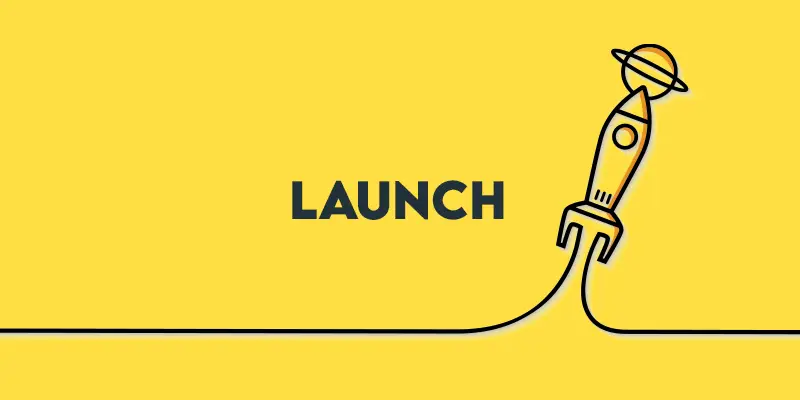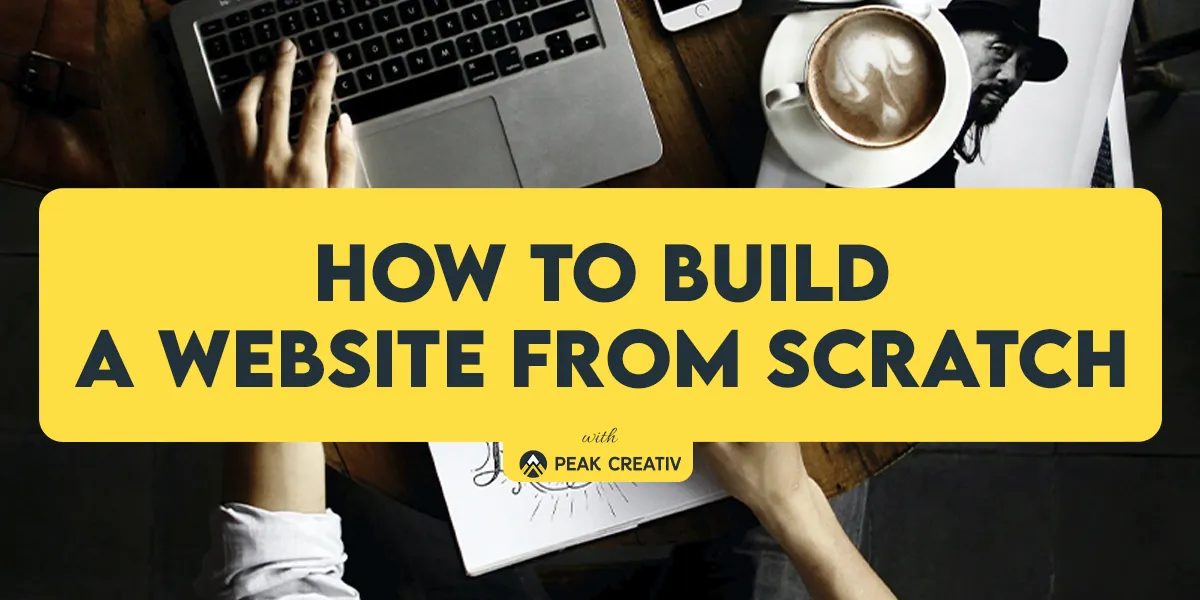We all know having a website is table stakes for running a small business. How often are you willing to go to a restaurant, consider a preschool for your kid, or walk into that auto repair shop if you know nothing about them, or can’t find them online? Probably not often. This post will walk you through the steps you need to consider to build a website from scratch. Of course, at the same time I have to plug my own business Peak Creativ here as well, since that is what we do, so if you want the easy way just hire me, but if you’re still interested in how to build a website from scratch….Here we go.
1. Choose a Domain Name for your website

Your domain name is your website’s address on the internet and plays a vital role in branding. It’s what you type into your browser to get directly where you are trying to go. When choosing a name, try to come up with a name that is short, memorable, and reflective of your business. Don’t be afraid to add words or get really creative as finding exactly what you want can be pretty tough.
Get Inspiration & Check Availability:
If you’re finding it hard to come up with a name that you like or that fits your business. Tools like NameMesh and Lean Domain Search allow you to input keywords and generate available domain names based on those terms. While .com is the most popular domain extension, don’t be afraid to consider others like .net, .org, or even more specific extensions like .store, .tech, or .blog, depending on your business.
Lock it Down & Register:
After you find a domain, you need to register (buy) the domain. Domains are generally registered on an annual basis, so keep that in mind, and usually cost about $20 -$40. I personally use Hover for all my personal domains, but you can use tons of other great options like GoDaddy or Wix to check the availability of your desired name, purchase it right there, and start building.
2. Select a Web Hosting Service & Building Platform

Integrated Service:
Here’s where the choices start to multiply. When you build a website from scratch you have to consider web hosting and a website platform because they are very different things. Many companies will bundle them together, but know they are different and do not need to be together. A service like Squarespace provides their own website builder and all their plans include hosting. Although they offer the tools to do it all, platforms like Squarespace still require you to make the website yourself, and if you need something different than what they offer or can’t get your website to look just like you want it, you’re generally on your own to figure it out or hire someone to do it for you.
Flexible Service:
Other options that provide more flexibility are services like Godaddy, hostinger, or bluehost. They offer both options, but separately. You can just buy hosting and not use their website builder if you want to build something more custom, but they also offer website builders. With these services you can pay lower monthly fees, but it’s also more technical to get things up and running if you decide to use your own website platform to design your website. There are other widely used platforms like WordPress, which is very populat and very powerful, but much more technical.
Full Service:
The last option is the hire a full service firm to take care of all of this for you. Generally a full service firm is going to cost significantly more than one of these other options, but the end product will probably look and work a lot more like you were picturing when you decided you wanted a website for your business. This category is where Peak Creativ (me) fits in. I offer full service, but for a much lower price than other large companies. Just wanted to provide context about what I do and where I fit in all this.
For a complete beginner that just wants something up and running quickly, hire us, it will be faster, look better, and have more features, but if you want to learn and build a website from scratch, I’d recommend Squarespace. They are widely supported online with tutorials and take care of many technical aspects you don’t really want to worry about.
3. Design Your Website

Once you’ve selected your hosting service and platform, it’s time to start designing your website. Most platforms will offer a variety of templates to get you started. A template serves as the foundation of your website design, like where pictures, text, menus, etc. are going to be. All the images, text, and sections in a template are customizable, but if you start with a design you like it will take a lot less work to make it what you want. So, take some time to browse the templates and choose one that aligns with your business sector and aesthetic preferences.
As you are choosing how you want your website to look. Make sure to also keep these things in mind:
- Mobile Responsiveness: With a significant portion of web traffic coming from mobile devices, ensure your website design is responsive and looks great on all screen sizes. You will probably work on your website on a laptop, but most of the traffic will come from mobile. Make sure it looks good on a phone too. Most editors have a setting that will help you see how it will look on mobile, so make sure to keep going back and forth so it looks good.
- User Experience (UX): A website’s success hinges on its usability. Navigation should be intuitive, with a clear path for users to follow to find information, products, or services. Menus should be straightforward, and important information should be no more than a few clicks away. Remember, a frustrated user is less likely to find what they need or convert into a customer.
- Loading Speed: Your website’s loading time is crucial for keeping potential customers engaged. A slow website can drive visitors away before they’ve even had a chance to see what you offer. It also affects where you show up in search. Optimize images, choose fast-loading templates, and consider your hosting service’s performance to ensure quick load times.
- Branding Consistency: Your website is an extension of your brand, so it’s important that it reflects your brand’s colors, fonts, and overall vibe. Consistent branding helps reinforce your identity and makes your business more memorable.
4. Implement SEO

Now that you’ve designed your website, don’t hit launch just yet. It may look pretty, but you want to make sure your website it ready for Google….A.K.A Search Engine Optimization (SEO). SEO is essential for making your website visible to more people. Implementing SEO best practices helps your site rank higher in search engine results, increasing your online visibility. Squarespace may give you hints as you build out your website to help your SEO. When we build a website from scratch we implement SEO as we are building each page and then do a check at the end to make sure everything is optimized, so you don’t even have to think about it. If you are working on your own website, here are couple important things to consider helping your SEO:
- Mobile Optimization: This was mentioned above, but this has a big advantage to your website’s SEO. Make sure you website works well on Mobile.
- Keywords: If you are hoping to grow your business then you should consider which words people are searching for. Identify terms and phrases your target audience uses when searching for products or services like yours. Incorporate these keywords naturally into your website’s titles, headings, content, meta descriptions, and URLs to improve your site’s relevance and visibility in search engine results.
- Quality Content: Depending on your business, you may want to regularly update your site with quality content. Blog posts, case studies, and customer testimonials can all contribute to your site’s SEO performance.
- Optimize for Speed: As mentioned in the section above, website loading speed affects your SEO rankings. Use tools like Google PageSpeed Insights to test your site’s speed and follow their recommendations to improve it.
5. Launch and Promote Your Website

Once you’re satisfied with your website, it’s time to launch. But the work doesn’t stop there. Promote your site through social media, email marketing, and by integrating it into your business cards and other marketing materials. If you are a local service business, go create a Google My Business profile so that you are eligible to be listed on google maps when people in your area search for businesses like yours. Encourage satisfied customers to leave reviews and share your site to help build credibility and attract more visitors.
Just hire me…it’s a lot easier.
If you build a website from scratch and on your own it can be challenging, but immensively rewarding. As you can see, there are a few things to think about as you build out your website, and I just touched on the big ones. If you don’t want to worry about any of this, just send me a message and let Peak Creativ do it all for you. We offer extremely competitive plans and do everything we mentioned in this article, so you know you are getting the best. We even make updates to your website whenever you want. If you do decide to tackle building a website yourself, it can be extremely satisfying to see it all come together and we are cheering you on!

